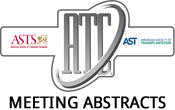Using Artificial Intelligence Tools for Identification of High Risk Transplant Recipients for Focused Management
1Saint Louis University, St. Louis, MO, 2Missouri S&T, Rolla, MO, 3CareDx, Brisbane, CA, 4University of Iowa, Iowa City, IA
Meeting: 2020 American Transplant Congress
Abstract number: 384
Keywords: Graft failure, Multivariate analysis, Prediction models, Prognosis
Session Information
Session Name: Quality Assurance Process Improvement & Regulatory Issues II
Session Type: Oral Abstract Session
Date: Saturday, May 30, 2020
Session Time: 3:15pm-4:45pm
 Presentation Time: 3:27pm-3:39pm
Presentation Time: 3:27pm-3:39pm
Location: Virtual
*Purpose: Resources for post-transplant patient monitoring are limited. Statistical stratification can facilitate focused attention on highest risk patients. We developed a monitoring tool for graft failure in adult deceased donor kidney (KiDDA) recipients using existing data available to all US transplant centers and free and open source software developed by Google for Artificial Intelligence (AI).
*Methods: Data from UNOS for 259,550 KiDDA recipients from 1987 to 2017 was used to fit six-layer dense neural network models (AI) for graft failure. 2017 was set aside to test accuracy. Estimation was performed in the R programming language using the packages Keras and TensorFlow. Explanatory variables are available to US transplant centers in a file available for download from UNOS.
*Results: AI ROCs in the test data were 0.75 for graft failure in the first post-transplant year and 0.80 in the first six months. ROCs for the most recent SRTR equation were 0.67. Six-month observed graft byb AI and SRTR estimated risk is presented in the figure. In 2017, AI identifies a small highest risk group (14% of total) who account for 50% of graft failures. SRTR finds 50% of graft failures in the 31% of highest risk patients. The highest risk 5% of patients by AI had 13.6% graft failure compared to 7.4% by SRTR.
Performance differences were due to variable inclusion. The center performance purpose prevents the SRTR from using certain variables apparently useful for identifying high risk patients. Limiting the variables available to the AI produced results similar to the SRTR equation. [figure1] The prediction model has been made into a package (“TxRisk”) for the R programming language. After installing TxRisk in R, downloading a file from UNOS, and submitting a single line command to R [example: KiDDA_risk(MOSL_TX1_CENTER_STAR_WL_TX_KP.dat)] an Excel file is produced with risk stratification of the center’s KiDDA patients.
*Conclusions: Existing post-transplant risk models have significant limitations: lacking statistical power, cumbersome implementation, expensive and invasive testing, and/or extensive manual data collection. However, highly predictive, minimal effort risk stratification for post-transplant management is possible with existing data. Future work will design and test visualizations and metrics that best support decision-making. The TxRisk R package is available by request from the authors as free and open source software.
To cite this abstract in AMA style:
Schnitzler MA, Dagli C, Canfield C, Dzebisashvili N, Varma C, Axelrod D, Lentine K, Ouseph R, Randall H. Using Artificial Intelligence Tools for Identification of High Risk Transplant Recipients for Focused Management [abstract]. Am J Transplant. 2020; 20 (suppl 3). https://atcmeetingabstracts.com/abstract/using-artificial-intelligence-tools-for-identification-of-high-risk-transplant-recipients-for-focused-management/. Accessed December 15, 2025.« Back to 2020 American Transplant Congress

